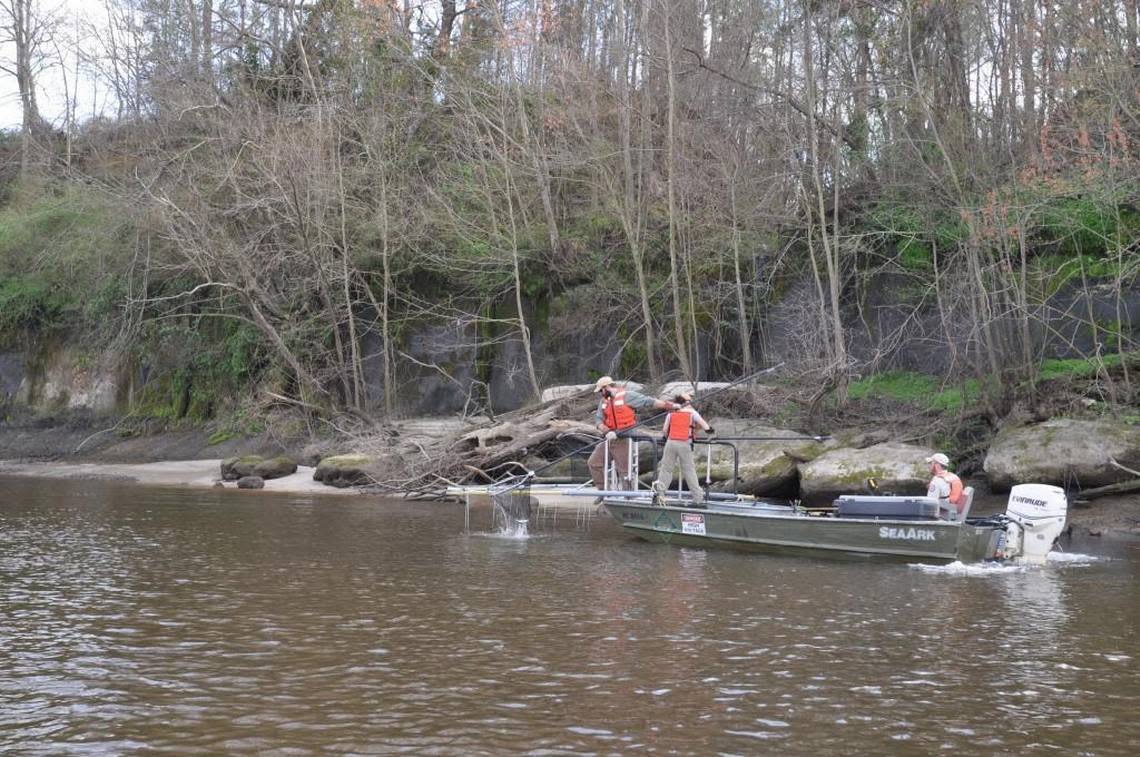Fish from parts of Cape Fear River shouldn’t be eaten due to PFAS levels, DHHS says

North Carolina’s Department of Health and Human Services recommended strict limits Thursday on eating fish caught in the Cape Fear River between Fayetteville and Wilmington, citing concern about forever chemicals found in their tissue.
DHHS issued a fish consumption advisory that recommends women of child-bearing age and children completely avoid bluegill, flathead catfish, largemouth bass, redear and striped bass caught from the middle or lower portions of the Cape Fear River. Those same groups should only eat one meal per year of American shad, blue catfish or channel catfish from the river, the advisory says.
The recommended limits aren’t much higher for everyone else.
All other people should limit themselves to one total meal a year of bluegill, flathead catfish, largemouth bass, redear or striped bass caught from the river, the advisory says. And they should only eat seven total meals of American shad, blue catfish or channel catfish from the river.
The advisory is based on more than 250 samples taken from the Cape Fear River last year by the N.C. Department of Environmental Quality and N.C. Wildlife Resources Commission. Those samples found high levels of PFOS in many samples.
“It’s difficult when you have contamination in a food that is otherwise a pretty healthful choice and we’re just hoping that this will help people balance that,” Virginia Guidry, North Carolina’s Occupational and Environmental Epidemiology branch head, told The News & Observer.
The area affected by the announcement extends from the Fayetteville Boat Ramp to the Bluffs on the Cape Fear River, just north of Wilmington. The advisory is effective immediately because it is not an enforceable rule but rather information provided to local communities.
Thursday’s announcement makes North Carolina the 15th state to issue fish consumption advisories for forever chemicals. Like North Carolina, the advisories in many other states tend to be based on PFOS, a so-called legacy compound that was phased out starting in 2002. PFOS accumulates in fish faster than other PFAS.
North Carolina’s advisory levels are stricter than those of many other states because they are the first to be based on a reference dose — a level at which a person can expect to be exposed for a lifetime without suffering adverse health effects. The U.S. Environmental Protection Agency released those reference doses in March
“We didn’t want to go ahead with creating advisories until that was available so that we wouldn’t have to go back and redo those calculations and create additional confusion for people,” Zach Moore, North Carolina’s state epidemiologist, told The News & Observer.
Community advocates are celebrating DHHS’ decision but have some lingering questions. Emily Donovan, a co-founder of Clean Cape Fear, has called for fish consumption advisories on the Cape Fear for years.
While DHHS’ action is important, Donovan told The News & Observer, it doesn’t address the people who have been eating fish caught in the Cape Fear River for decades.
“(The advisory says) don’t eat it, but that doesn’t include if you’re already a severely contaminated community from drinking water. This does not account for cumulative impacts,” Donovan said.
Moore, the state epidemiologist, said North Carolina has created a memo that patients can share with their doctors if they live in Southeastern North Carolina or otherwise have reason to believe they’ve been chronically exposed to PFAS.
“We didn’t get trained on this stuff in medical school. It’s a new topic for a lot of providers out there, so we want to make sure that we’re empowering the providers and the people who are seeing them to have conversations and see where the guidance is,” Moore said.
Residents in the Cape Fear region have grappled with PFAS contamination since 2017, when it was revealed that Chemours and predecessor DuPont had been discharging GenX into the Cape Fear River for decades. Thursday, DEQ officials told the Environmental Management Commission that a barrier wall has been completed that is meant to prevent groundwater contamination from beneath Chemours’ Bladen County facility from reaching the Cape Fear River.
Chemours officials contend that their company, which was spun off of DuPont in a 2015 restructuring, has never manufactured PFOS. The chemical is more commonly associated with 3M and was used in fire-fighting foam, stain-resistant fabrics and water-resistant food packaging, among many other places that span the economy.
The DHHS advisory specifically addresses PFOS because it is the chemical that officials know the most about. It is not, however, the only one that was found in DEQ’s samples of fish taken from the Cape Fear.
“We’re hopeful that by using the new reference dose, which is based on the current science and is a very low value, that this will be protective of any potential health effects that may occur,” Guidry said. “That said, we know that there’s a gap there with other PFAS being measured in the fish.”
DHHS officials are particularly worried about people who are using fish caught in the Cape Fear River as a key source of protein in their diets. A 2022 report from Duke University and Oakland University researchers found those people were more likely to be low-income or food insecure.
“Some people may not have a lot of other options and yet we want people to have this information so that if they do have safer options they can potentially choose to eat other protein sources. But we know that’s going to be a challenge,” Guidry said.
This story was produced with financial support from 1Earth Fund, in partnership with Journalism Funding Partners, as part of an independent journalism fellowship program. The N&O maintains full editorial control of the work.






